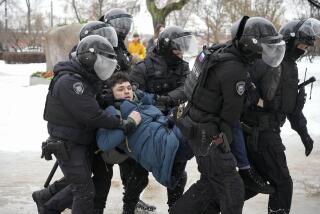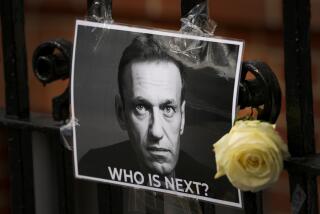Nationalism May Be New Soviet ‘Ideological Glue’ : Ethnic strife: Analysts see it replacing seven decades of force and socialism in the disintegrating country.
- Share via
WASHINGTON — In the bewildering swirl of events surrounding the disintegration of the Soviet Union, Thursday’s arrest in Kiev of Igor Smirnov barely rated as even a ripple.
But for Western analysts peering ahead at what may happen in the disintegrating country, the activities of Smirnov, a leader of Russians living in the newly independent republic of Moldova accused of promoting last week’s coup attempt, are a troubling portent.
Although Smirnov himself is obscure, the force he represents is one of the most powerful--and at times destructive--in modern politics: nationalism.
For seven decades, the Soviet Union has been held together as a multinational state by force combined with the ideology of socialism. As that ideology became fully discredited, force alone has proven insufficient to bind a society of more than 100 national groups spread across one-sixth of the Earth.
“So what is now available as an ideological glue” to hold together the new societies that are forming? asks Ronald G. Suny, a historian at the University of Michigan. Liberalism, tolerance and attempts to imitate the West may hold sway among intellectuals in Moscow and Leningrad, he notes. But “in terms of a broad movement that would reach beyond the cities, nationalism is the most likely.”
Nationalism, patriotism and love of country have often been positive forces. And some experts on Soviet history believe that the cohesion and sense of purpose that nationalism can provide may prove to be the driving force that will allow the diverse peoples of the Soviet Union to survive the hardships that they are likely to face in the future.
“National self-determination is not the problem,” says Harvard University’s Roman Szporluk. “The collapse of communism is the problem, and the rise of nations is a solution.” On the other hand, he admits, “it often happens to solutions that they cause new problems.”
National sentiment can easily be twisted to malignant ends. Already, for example, in some republics, such as Byelorussia, the Old Guard Communist leaders have tried to use nationalist sentiment--and independence declarations--as a way to shield themselves against the tide of reform that is flowing from Moscow.
In other cases, such as Russia itself, nationalism’s positive side has often been overtaken by a darker, brutal and aggressive cast through the years--a conviction that Russians are an imperial people destined to rule over smaller nationalities around them.
Because of that history, the sight of Russia--in the person of Russian Federation President Boris N. Yeltsin--emerging to grab for the power that was once in the hands of the multinational Soviet Union can be frightening for many--both within the Soviet Union itself and in neighboring countries.
Neighbors remember the czarist regime’s centuries of expansionist warfare. Earlier this week, for example, Iran’s foreign minister, Ali Akbar Velayati, warned on Tehran Radio that Yeltsin was emerging as “a partisan of modern czarism” and encouraging “the spread of nationalist tendencies” that could be dangerous for neighboring countries. Russian armies clashed often with what was then known as Persia in the last two centuries. In this century, the Soviet army briefly occupied part of Iran’s territory after World War II.
Within the country, minority groups recall that during the days of the czars, particularly in the 19th Century, Russian policy tried to suppress other native languages and cultures within the empire. Moscow banned the use of Polish, Ukrainian or the Baltic languages in secondary or higher education, for example. In Central Asia, the czars seized vast tracts of land from the semi-nomadic residents and distributed it among Russian peasants.
Under Soviet rule, Moscow followed a more complex policy. V. I. Lenin, the founder of the Soviet state, disdained nationalism, arguing that it was merely a tool used by the wealthy to divide the working class. But at the same time, Lenin was not above using nationalist feelings to divide his opponents when necessary. And his successors, particularly Josef Stalin, frequently sought to manipulate national feelings as part of a “divide and rule” strategy.
Official Soviet ideology--except during World War II, when Stalin used appeals to nationalism and Russia’s past to try to rally his people against the invading Germans--was to try to replace Russian nationalism with “Sovietism.” And in the republics, the policy was designed to foster loyalty to Moscow by creating national “homelands” and local elites.
The policy has had some success, according to those who have studied Soviet public opinion.
A recent extensive survey of attitudes in Russia, the Ukraine and Lithuania by the Times Mirror Center for People and the Press, for example, found that a large percentage of Russians said they did not know whether they would describe their countrymen as patriotic or unpatriotic.
In the smaller republics, many of the elite stayed loyal to Moscow until quite recently. But ironically, by creating “national” boundaries, however artificial, and national institutions, from opera companies to regional academies of science, the Soviet policy has helped foster the very sort of nationalist sentiment it was ostensibly designed to wipe out, historian Suny notes.
And as controls on speech, politics and the press have been loosened, resentments and nationalist feelings have come rapidly to the fore.
In the smaller republics, many of those resentments are focused on Russians. “For many people in the Soviet Union, Moscow is an outside actor,” the seat of an imperial power that has long tried to dominate and manipulate other national groups, says Martha Olcott, a historian at Colgate University who has traveled extensively in Soviet Central Asia. For those groups, any increase in Russian power is seen as a decrease in their own autonomy.
What is happening now is the continuation of a nation-building process that was frozen in time with the Communist takeover in 1917, Olcott says. Until that process is sorted out, no new central structures for the union are likely to be stable, she argues. “They can sign a treaty now, but in three weeks there could be some kind of violent ethnic confrontation--planned or spontaneous--and the whole thing could fall apart.”
The process now under way in what has been the Soviet Union “is analogous to what we see in the Middle East,” Olcott says. “National boundaries were established by outside actors that did not correspond with the aspirations of the people. Now we see people trying to sort out who they are.”
The comparison to the Middle East, she concedes, “is not a very hopeful analogy.”
Condoleezza Rice, the former Soviet policy chief at the National Security Council, offers a similarly pessimistic analogy. “What’s really happening here is an empire breaking up,” she says. “Even in the best of circumstances, when empires break up, they leave problems.”
The most immediate problems involve about 25 million ethnic Russians living outside of the Russian republic’s territory. In the Ukraine, for example, Russian-speakers dominate large chunks of the eastern part of the republic, particularly in the Crimea and the heavily industrialized Don Basin. In Kazakhstan, native Kazakhs are outnumbered by Russian-speakers. In Kirghizia, Russians are a minority, but heavily dominate the republic’s capital city of Frunze.
Over the past few years, Soviet hard-liners have tried to manipulate those Russian populations, using them as weapons against independence-minded groups in several republics.
Smirnov’s Moldovan group provides a prime example of that sort of manipulation. The situation in Moldova, a senior U.S. analyst says, is “the biggest problem” on the immediate horizon.
Most Moldovans are ethnically Romanian. But in the industrial slice of the republic that lies along the Dniester River, a large population of Russians and Ukrainians has grown up. As Moldovans began to agitate for independence from the Soviet Union, those communities declared their intention to secede from Moldova.
The implied threat was that, if the Moldovans did not agree to give up territory, Smirnov--who is still detained--and his colleagues would appeal to their countrymen in Moscow for armed force to help. When Moldovan commandos tracked Smirnov down in the Ukraine, he reportedly was in the company of a hard-line Ukrainian Communist whose assistance he may have been soliciting.
So far, Yeltsin and the people around him have generally been careful to avoid stirring up nationalist sentiment. Indeed, during the campaign in which Yeltsin won the Russian Federation presidency earlier this year, he carefully avoided the nationalist rhetoric used by one of his opponents, Vladimir V. Zhironovsky, the senior analyst said. Zhironovsky was badly beaten but did garner about 5 million votes, he noted.
But at times, even Yeltsin has seemed to be taking a harder line. Early this week, for example, Russian officials released a statement attributed to Yeltsin that suggested Russia would seek border changes if neighboring republics sought independence. But Yeltsin quickly backed away after furious responses from both the Ukraine and Kazakhstan and dispatched top Russian officials to both republics for successful talks about cooperation.
While Russian chauvinism, so far, may be in check, “if there’s real hunger this winter and people can’t live with dignity, then there’s the possibility of an extremist group taking power,” says John Dunlap of the Hoover Institution. Such extremists could easily try to use the plight of Russians in the smaller republics as a pretext for open war.
Moreover, Russian sentiment is only one of the potentially dangerous sorts of nationalistic feelings that could threaten the Soviet future.
For the past three years, fighting raging in the Soviet south between Armenians and Azerbaijanis has claimed hundreds, if not thousands, of lives. The fighting, which began over control of a mostly Armenian enclave within Azerbaijan known as Nagorno-Karabakh, has become a metaphor within the Soviet Union for all the dangers that uncontrolled nationalism can carry, Michigan’s professor Suny says.
Indeed, during the demonstrations outside the Russian Parliament building during the early days of the coup last week, some people carried banners warning against future Karabakhs, Suny noted.
Farther east, in Soviet Central Asia, nationalism has been intimately bound up with the rise of Islamic fundamentalism. The Uzbeks, in particular, have pursued an openly expansionist policy toward their neighbors in Kazakhstan and Tadzhikistan, Olcott noted. Uzbeks control many of the major cities of the region, such as Samarkand, and have clashed repeatedly with their neighbors.
As a result, some Tadzhiks, who are Persian in origin by contrast with the Turkic people in the rest of the region, have talked of seeking a union with Afghanistan to the south to avoid being swallowed by their Uzbek neighbors. And the Kazakhs, squeezed by Russians to the north and Uzbeks to the south, not surprisingly have been among the groups most actively pushing for a new form of union.
For now, with communism in collapse and the old guard still reeling from the defeat of its bungled coup, many see hope despite the legacy of strife. “As a historian,” said Harvard’s Szporluk, “I see one of those moments that could go well.”
But, he conceded, the situation could hardly be more delicate. “One stupid speech, one move by a general, could turn the whole thing in the wrong direction,” he said.
More to Read
Sign up for Essential California
The most important California stories and recommendations in your inbox every morning.
You may occasionally receive promotional content from the Los Angeles Times.











